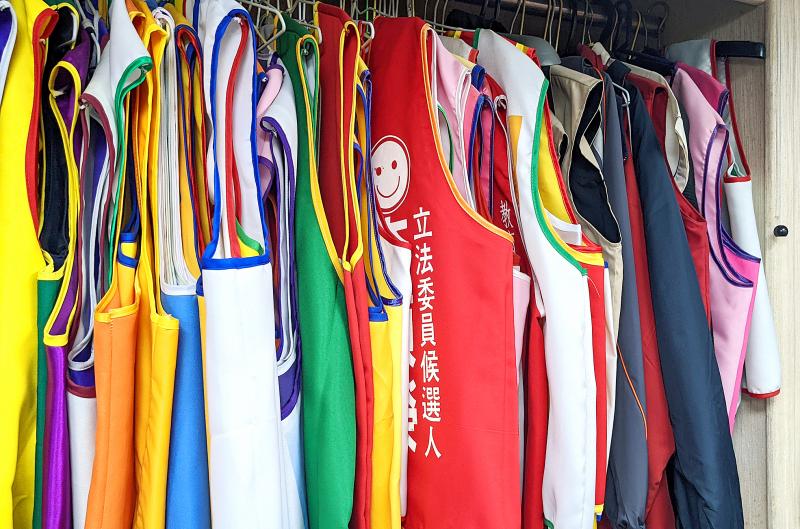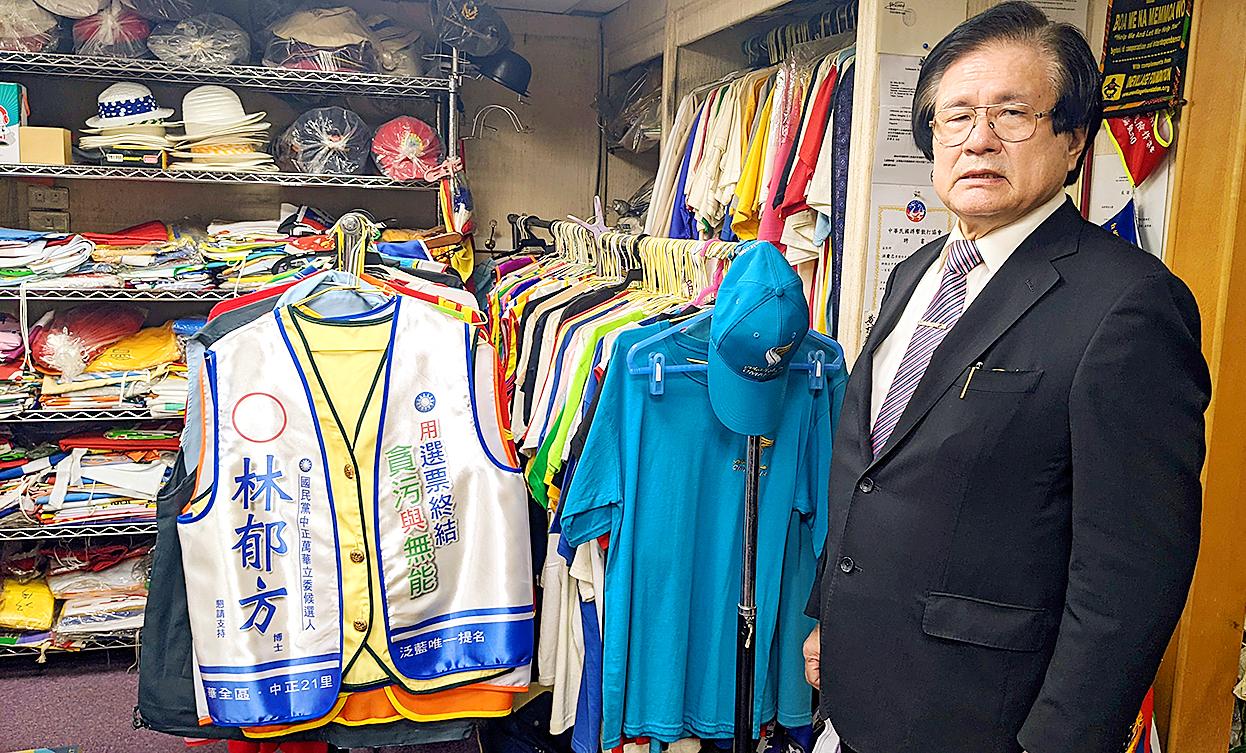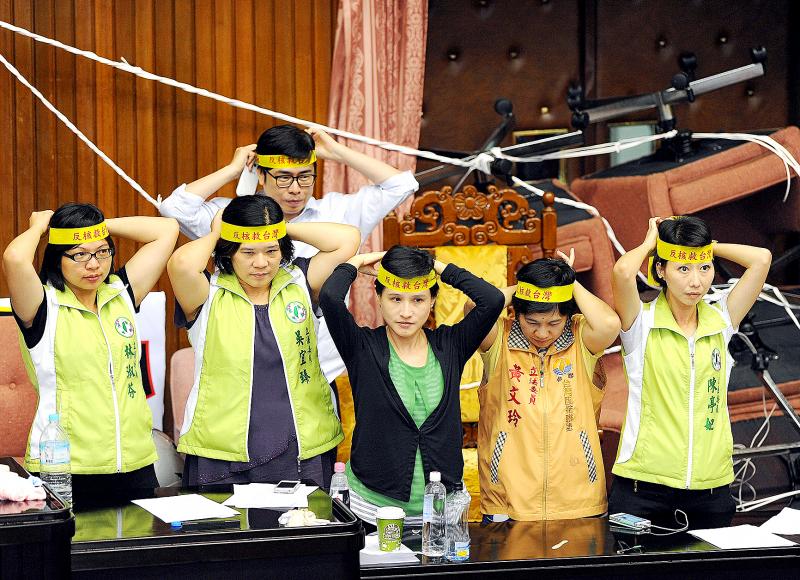Huang Li-yu (黃麗伃) doesn’t think it’s possible to campaign for public office without a vest.
Those who have experienced Taiwan’s fervent, colorful election seasons will know what she’s talking about: the brightly-colored, polyester “uniforms” emblazoned with the candidates’ name, number, party and perhaps a slogan or two.
“In the current political climate, these vests are a must,” says Huang, the borough warden of Yongan Borough in New Taipei City’s Sanchong District (三重). “When you’re campaigning, you’re trying to be seen by those who don’t know you. If you don’t wear them, nobody would even know that you’re campaigning.”

Photo: Han Cheung, Taipei Times
Taiwanese voters pay attention to the size and fighting spirit of a candidate’s campaign team, Huang says, which can be accentuated with all members wearing identical vests.
However, there’s little information on how these vests became a uniquely Taiwanese election phenomenon. One of the few online sources is a 2019 video by YouTuber-turned-Taipei City Councilor Chiu Wei-chieh (邱威傑), better known as Froggy (呱吉).
Chiu doesn’t hide his distaste for these garments in the video, and he customized his own when he ran for office in 2018.

Photo: Han Cheung, Taipei Times
“Elections are similar to beauty pageants; the candidates present themselves on stage in hopes of being chosen. But the difference here is that pageant contestants are dressed beautifully, while election candidates wear these hideous vests,” he says. “If you look at the US, Japan and other countries, none of them have this culture of wearing campaign vests.”
VESTED INTERESTS
Mike Hung (洪慶忠) has been to 138 countries and met more than 50 presidents. His expandable business card lists him as the Chairman of the Taiwan Africa Industry Development Association, Honorable Chairman of the Taiwan Pro-Wrestling Foundation, Chairman of International Affairs at the National Association of Small & Medium Enterprise and Executive Supervisor of the Taiwan Health Movement Alliance.

Photo: Fang Pin-chao, Taipei Times
But his main hustle is running Mike Hung Products Co (嘜德有限公司), which has created all sorts of promotional accessories — especially vests — for politicians, temples, charities, volunteer groups and other occasions for more than four decades. His office is like a museum, with countless samples, artifacts and walls plastered with photos of him posing with notable figures.
While candidates have been seen wearing vests in local elections since at least the 1970s, Hung says the practice took off with the first direct presidential elections in 1996.
Lee Tsung-hsing (李宗興), owner of Li Daji Gifts (李大吉禮品) in Taipei, says he started seeing more campaigners wear these vests in the 1980s with the rise of the Dangwai (黨外) opposition movement and the end of the Chinese Nationalist Party’s (KMT) one-party rule. He adds that they became popular in temples and volunteer organizations around the same time.

Photo: CNA
“There was a whole crop of new politicians who needed to get their name out,” Lee says. “Before, it was mostly the same old folks running. The vests proved to be effective advertising, and eventually they became election necessities.”
Practicality was the appeal at first. The vests are cheap, waterproof, can be made in a day and come in one size. They’re also easy to put on and take off according to campaign needs.
Some candidates bought them by the tens of thousands, Hung says, recalling Hsieh Shen-shan’s (謝深山) order when he ran for Taipei County Magistrate in 1997. Former president Chen Shui-bian (陳水扁) was one of the first to print slogans on the vests during his presidential bid in 2000, Hung adds.

Photo: Huang Mei-chu, Taipei Times
Those were the golden years, Lee says. Not only were there an unprecedented number of high-profile elections, there was also a proliferation of new political parties. It was common to see up to nine candidates running for one legislative seat, and each one wanted vests.
Hung says that these vests became a hit in Taiwan because they give off an image of approachability, making candidates more relatable to voters.
“That’s very important in Taiwanese elections,” he says. “You just can’t go into communities and campaign in a suit.”
NEW LOOK
These days, more fashion-conscious candidates are eschewing the traditional stock vests, preferring to custom-make their own. When Chiu ran for office in 2018, his team spent a lot of time looking for a company that could offer alternative cuts and better materials. They ended up with a slick all-black vest with pink embroidered text for the campaign team.
“Although good design doesn’t indicate a good candidate or good party, candidates should pay attention to campaign aesthetics as part of the battle. As Taiwan’s election system matures, people will increasingly care about the quality and style of presentation,” Chiu says.
At first, there wasn’t much of a unified style for vests or other campaign apparel, even within the same parties. But in the past two decades or so, another type of vest has emerged — a more proper looking, higher-end one that the candidate can wear to all sorts of occasions.
Both Hung and Lee’s companies have seen an increase in demand for these vests as parties strive for a more unified look in public.
Yang Chia-wei (楊家緯) writes in the study, Yundong: Dress of Male Politicians during Election Campaigns in Taiwan (運動:臺灣選舉活動中男性政治人物的穿著) that these are often dubbed “battle robes.” Party members are required to wear them during large events or showdowns over contentious issues in the Legislative Yuan, where violent conflicts may erupt and it’s important for the combatants — and the media — to know who is who.
Overall, Hung says sales for the election vests have been dropping as candidates focus more on online campaigning instead of canvassing the streets. The government has also tightened regulations on campaign funding, and growing environmental restrictions and concerns have also cut into the demand for disposable promotional material.
Will this trend ever catch on in other countries? Hung says it has to a certain degree — many African or Central American nations that he works with have emulated Taiwan in displaying large numbers of election hats, shirts, flags, banners and so on.
He shows me hats that he has made for politicians in the Democratic Republic of Congo, Burkina Faso and Chad. However, the vests have yet to catch on.
“They can’t get used to it,” he says. “So it remains a unique Taiwanese phenomenon.”

That US assistance was a model for Taiwan’s spectacular development success was early recognized by policymakers and analysts. In a report to the US Congress for the fiscal year 1962, former President John F. Kennedy noted Taiwan’s “rapid economic growth,” was “producing a substantial net gain in living.” Kennedy had a stake in Taiwan’s achievements and the US’ official development assistance (ODA) in general: In September 1961, his entreaty to make the 1960s a “decade of development,” and an accompanying proposal for dedicated legislation to this end, had been formalized by congressional passage of the Foreign Assistance Act. Two

March 31 to April 6 On May 13, 1950, National Taiwan University Hospital otolaryngologist Su You-peng (蘇友鵬) was summoned to the director’s office. He thought someone had complained about him practicing the violin at night, but when he entered the room, he knew something was terribly wrong. He saw several burly men who appeared to be government secret agents, and three other resident doctors: internist Hsu Chiang (許強), dermatologist Hu Pao-chen (胡寶珍) and ophthalmologist Hu Hsin-lin (胡鑫麟). They were handcuffed, herded onto two jeeps and taken to the Secrecy Bureau (保密局) for questioning. Su was still in his doctor’s robes at

Last week the Democratic Progressive Party (DPP) said that the budget cuts voted for by the China-aligned parties in the legislature, are intended to force the DPP to hike electricity rates. The public would then blame it for the rate hike. It’s fairly clear that the first part of that is correct. Slashing the budget of state-run Taiwan Power Co (Taipower, 台電) is a move intended to cause discontent with the DPP when electricity rates go up. Taipower’s debt, NT$422.9 billion (US$12.78 billion), is one of the numerous permanent crises created by the nation’s construction-industrial state and the developmentalist mentality it

Experts say that the devastating earthquake in Myanmar on Friday was likely the strongest to hit the country in decades, with disaster modeling suggesting thousands could be dead. Automatic assessments from the US Geological Survey (USGS) said the shallow 7.7-magnitude quake northwest of the central Myanmar city of Sagaing triggered a red alert for shaking-related fatalities and economic losses. “High casualties and extensive damage are probable and the disaster is likely widespread,” it said, locating the epicentre near the central Myanmar city of Mandalay, home to more than a million people. Myanmar’s ruling junta said on Saturday morning that the number killed had